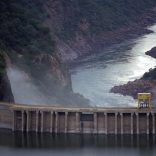Mozambique: Over 18,000 “ghost workers” found in public service
Mozambique: Real GDP growth projected to 2.7% in 2025 and 3.5% in 2026 ” pushed by rebound in extractive sector activities’ – AfDB

Source: Data are as of May 2025 and are from domestic authorities; figures for 2024 are estimates and figures for 2025 and 2026 are projections by the African Economic Outlook team [AfDB]
Mozambique’s “real GDP growth is projected to increase to 2.7% in 2025 and 3.5% in 2026, pushed by a rebound in extractive sector activities,” the African Development Bank (AfDB) said in its African Economic Outlook report.
“Inflation is projected to increase to 4.8% in 2025 and further increase to 5.2% in 2026 due to increased local food prices,” the AfDB added in the ‘Country Notes’ on Mozambique in the 2025 African Economic Outlook report (page 269).
The forecasts for Mozambique follow a subdued GDP growth of 1.8% in 2024, “a significant decline from 5.4% growth in 2023, driven by declining output in extractive industries and agriculture”, notes the AfDB – also recalling that “inflation declined to 3.2% in 2024 from 7.0% in 2023, reflecting tight monetary policy and a stable exchange rate”.
Now, “the fiscal deficit is projected to widen to 5.4% of GDP in 2025 and then narrow 4.5% in 2026 due to fiscal consolidation”.
READ: AfDB Summit: Stronger growth seen for Africa as it weathers tariff shock
The African Economic Outlook 2025 was launched on Tuesday in Abidjan, Ivory Coast, during the AfDB annual meetings, whose central theme is the mobilization of the continent’s resources, freeing it from external dependence, hence the motto: ‘Making Africa’s Capital Work Better for Africa’s Development’.
In the case of Mozambique, the key downside risks to growth include “climate change, social unrest and its effects on economic activities, ODA cuts [cuts in Official Development Assistance/ foreign aid] and trade tensions” at a global level.
The AfDB advises mitigation measures such as “improving spending efficiency, diversifying export markets with promotion of value-added industries to boost domestic consumption, and fostering dialogue among all political parties”.
One of the indicators highlighted in the analysis concerns the low tax-to-GDP ratio, at around 23%, ” falling below regional benchmarks, signaling unrealized fiscal potential”.
“Revenue mobilization is constrained by illicit financial flows, estimated at $1.3 billion annually, and by weak tax administration,” it adds.
On the other hand, the state’s “high wage bill, averaging 90% of tax revenue (2021–23) and rising debt service obligations significantly limit the fiscal space for development spending”.
“Exiting the Financial Action Task Force Grey List, tackling illicit financial flows, enforcing public-private partnership regulations will be essential to improving the investment climate and boosting economic resilience,” the document concludes.
READ: AfDB cuts Africa’s 2025 growth forecast on trade tariffs uncertainty
CPLP: Outgoing AfDB chief pleased with successes in Portuguese African nations












Leave a Reply
Be the First to Comment!
You must be logged in to post a comment.
You must be logged in to post a comment.